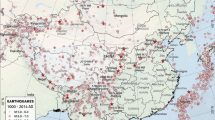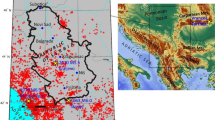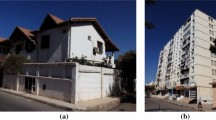Abstract
Large-scale impacts from natural disasters suffered by society encourage researchers and public agencies to develop methods to evaluate, mitigate, respond, and recover from these events. A key aspect for the calculation of the potential earthquake losses is to properly describe the characteristics and value of assets exposed to seismic hazard. This article describes a methodology to develop an exposure model at a census-block resolution for residential structures in Chile using statistical data. The methodology is based on three steps: (1) obtaining dwelling count, construction material and location from census data, (2) defining classification rules for dwellings associated with houses and apartment buildings, and (3) assigning structural typologies and replacement cost. The resulting exposure model consists of a database with the number of residential structures classified into 18 structural typologies at each census block and the associated replacement cost. A total of 4,259,804 residential structures were identified in the national exposure model. Overall, clay brick and concrete block masonry account for 53.5 % of the structures of the country followed by timber (33.7 %), reinforced concrete (8.1 %), and adobe (4.6 %). Also, a methodology using remote digital survey techniques is proposed and used to obtain local exposure models for the cities of Iquique, Rancagua, and Osorno. The results of the national exposure model are compared with the local exposure models. An important feature of the proposed methodologies is that the building stock is classified into structural typologies, which is a key aspect for conducting seismic risk assessment. The methodologies used to construct the national and local exposure models may be extrapolated to other countries by adjusting the classification rules. The exposure models that were constructed represent an important input for risk calculations, by improving the technical capabilities for seismic risk management of the country.







Similar content being viewed by others
References
Astroza M, Moroni O, Brzev S, Tanner J (2012) Seismic performance of engineered masonry buildings in the 2010 Maule Earthquake. Earthq Spectra 28(1):385–406
Bhaduri B, Bright E, Coleman P, Urban ML (2007) LandScan USA: a high-resolution geospatial and temporal modeling approach for population distribution and dynamics. GeoJournal 69:103–117. doi:10.1007/s10708-007-9105-9
Borfecchia F, Pollino M, De Cecco L, Lugari A, Martini S, La Porta L, Ristoratore E, Pascale C (2010) Active and passive remote sensing for supporting the evaluation of the urban seismic vulnerability. Italian J Remote Sens 42(3):129–141
Bravo D, Larrañaga O, Millán I, Ruiz M, Zamorano F (2013). Final report. External reviewer commission of the 2012 census (in Spanish)
Calvi GM, Pinho R, Magenes G, Bommer JJ, Restrepo-Vélez LF, Crowley H (2006) Development of seismic vulnerability assessment methodologies over the past 30 years. ISET J Earthq Technol 43(3):75–104
De Bono A, Mora MG (2014) A global exposure model for disaster risk assessment. Int J Disaster Risk Reduct 10:442–451
Dell’Acqua F, Gamba P, Jaiswal K (2013) Spatial aspects of building and population exposure data and their implications for global earthquake exposure modeling. Nat Hazards 68:1291–1309. doi:10.1007/s11069-012-0241-2
EERI (2014) M8.2 Iquique, Chile earthquake and tsunami: preliminary reconnaissance observations. https://www.eeri.org/2014/04/m8-2-iquique-chile-earthquake-and-tsunami-preliminary-reconnaissance-observations/. Accessed 20 June 2016
ESRI (2011) ArcGIS desktop: release 10. Environmental Systems Research Institute, Redlands
Gamba P (2014) Image and data fusion in remote sensing of urban areas: status issues and research trends. Int J Image Data Fusion 5(1):2–12. doi:10.1080/19479832.2013.848477
Geiss C, Taubenböck H (2013) Remote sensing contributing to assess earthquake risk: from a literature review towards a roadmap. Nat Hazards 68(1):7–48. doi:10.1007/s11069-012-0322-2
Geiss C, Taubenböck H, Tyagunov S, Tisch A, Post J, Lakes L (2014) Assessment of seismic building vulnerability from space. Earthq Spectra 30(4):1553–1583
Geiss C, Aravena P, Marconcini M, Taubenböck H (2015) Estimation of seismic buildings structural types using multi-sensor remote sensing and machine learning techniques. ISPRS J Photogramm and Remote Sens 104:175–188
Google Inc (2015) Google street view. http://www.google.com/maps/streetview/. Accessed 10 October 2015
Guha-Sapir D, Below R, Hoyois P (2015) EM-DAT: international disaster database 2015. www.emdat.be. Université Catholique de Louvain. Brussels, Belgium
Indirli M, Razafindrakoto H, Romanelli F, Puglisi C, Lanzoni L, Milani E, Munari M, Apablaza S (2011) Hazard evaluation in Valparaíso: the MAR VASTO project. Pure Appl Geophys 168:543–582. doi:10.1007/s00024-010-0164-3
Instituto Nacional de Estadísticas (INE) (2014) Population projections 2014 (in Spanish). http://www.ine.cl/canales/chile_estadistico/demografia_y_vitales/proyecciones2014/proyecciones-de-poblacion-2014.xlsx
Instituto Nacional de Normalización (INN) (2003) NCh2123 Of. 1997 Mod. 2002. Confined masonry—design and calculation requirements (in Spanish). Santiago, Chile
Instituto Nacional de Normalización (INN) (2009b) NCh1928 Of. 1993 Mod. 2009. Reinforced masonry—design and calculation requirements [in Spanish]. Santiago, Chile
Instituto Nacional de Normalización INN (2009) NCh433 Mod. 2009 Earthquake resistant design of buildings [in Spanish]. Santiago, Chile
Jaiswal K, Wald D, Porter K (2010) A global building inventory for earthquake loss estimation and risk management. Earthq Spectra 26(3):731–748
Jaiswal KS, Petersen MD, Rukstales K, Leith WS (2015) Earthquake shaking hazard estimates and exposure changes in the conterminous United States. Earthq Spectra. doi:10.1193/111814EQS195M
Jordan CJ, Adlam K, Lawrie K, Shelley W, Bevington J (2014) User guide: windows tool for field data collection and management. GEM Technical Report 2014-04 V1.0.0. GEM Foundation, Pavia, Italy. doi: 10.13117/GEM.DATA-CAPTURE.TR2014.04
Jünemann R, de La Llera JC, Hube MA, Kausel E (2015) A statistical analysis of reinforced concrete wall buildings damaged during the 2010, Chile earthquake. Eng Struct 82:168–185
MAR VASTO (2015). MAR VASTO Manejo de riesgos en Valparaíso, servicios técnicos. http://www.marvasto.bologna.enea.it. Accessed 8 Sept 2015
Matsuka P, Chanussot J, Pathier E, Guéguen P (2012). A support vector regression approach for building seismic vulnerability assessment and evaluation from remote sensing and in situ data. In: Proceedings of IEEE International Geoscience and Remote Sensing Symposium. Munich, Germany, pp 7533–7536
Ministerio de Vivienda y Urbanismo (MINVU) (2015) External resolution N°0062. Fixes unit construction costs to apply in the calculation of rights of municipal permits (in Spanish). Santiago, Chile
Mueller M, Segl K, Heiden U, Kaufmann H (2006) Potential of high-resolution satellite data in the context of vulnerability of buildings. Nat Hazards 38:247–258. doi:10.1007/s11069-005-8637-x
OECD (2012) Disaster risk assessment and risk financing. A G20/OECD methodological framework. G20 2012, Mexico
Osorio FA, Acevedo AA, Jaramillo JD (2015) Methodology for the development of a seismic exposure model for Antioquia (Colombia). Memorias del VII Congreso Nacional de Ingeniería Sísmica. Universidad de los Andes and Asociación Colombiana de Ingeniería Sísmica. Bogotá, Colombia
Pina FE, Gonzalez P (2014) Estimating risk for Santiago, Chile due to deep intraplate and interface earthquakes. In: Proceedings of the 10th national conference in earthquake engineering, earthquake engineering research institute, Anchorage, AK, United States of America. doi: 10.4231/D3J678X45
Pittore M, Wieland M (2013) Toward a rapid probabilistic seismic vulnerability assessment using satellite and ground-based remote sensing. Nat Hazards 68:115–145. doi:10.1007/s11069-012-0475-z
Pittore M, Wieland M, Fleming K (2016) Perspectives on global dynamic exposure modelling for geo-risk assessment. Natural Hazards. doi:10.1007/s11069-016-2437-3
Schauss A (2015) The joint use of remote sensing and volunteered geographic information for exposure estimation. Master thesis, Faculty of Chemistry and Geoscience, Heidelberg University, Germany
Servicio de Impuestos Internos (SII) (2013) Exempt resolution N°108. Fixes values of terrains and constructions, and technical definitions for the re-appraisal of non-agricultural with residential destination, and the corresponding to non-built sites, abandoned properties, and ballast water wells in urban areas second- series real states (in Spanish). http://www.sii.cl/documentos/resoluciones/2013/reso108.pdf
Tapia P, Roldán W, Villacis C (2002) Seismic vulnerability of the northern cities of Chile: Arica, Antofagasta, and Copiapó (in Spanish). VIII Jornadas Chilenas de Sismología e Ingeniería Antisísmica. Universidad Técnica Federico Santa María. Valparaíso, Chile
TECHO (2014) Transparency report 2014 (in Spanish). TECHO Chile. http://www.techo.org/paises/chile/transparencia/informe-de-transparencia/. Accessed 26 Jan 2015
United Nations (UN) (2014) The demographic situation in the world, 2014. Concise report (in Spanish). Department of Economic and Social Affairs, Population Division ST/ESA/SER.A/354, United Nations. New York, United States of America
United Nations University Institute for Environment and Human Security (UNU-EHS), Alliance Development Works (ADW) (2014) World Risk Report 2014: focus—the city as a risk area
United Stated Geological Survey (USGS) (2015) Earthquake hazards program. http://earthquake.usgs.gov/. Accessed 25 Nov 2015
Villacis CA, Cardona CN (1999). RADIUS methodology. Guidelines for the implementation of earthquake risk management projects. Geohazards International, Palo Alto, California
Wieland M, Pittore M, Parolai S, Zschau J, Moldobekov B, Begaliev U (2012) Estimating building inventory for rapid seismic vulnerability assessment: towards an integrated approach based on multi-source imaging. Soil Dyn Earthq Eng 36:70–83
Wieland M, Pittore M, Parolai S, Begaliev U, Yasunov P, Niyazov J, Tyagunov S, Moldobekov B, Saidiy S, Ilyasov I, Abakanov T (2015) Towards a cross-border exposure model for the earthquake model central Asia. Ann Geophys 58(1):S0106. doi:10.4401/ag-6663
Worldpop (2015). Worldpop. http://www.worldpop.org.uk/. Accessed 15 Sept 2015
Author information
Authors and Affiliations
Corresponding author
Rights and permissions
About this article
Cite this article
Santa María, H., Hube, M.A., Rivera, F. et al. Development of national and local exposure models of residential structures in Chile. Nat Hazards 86 (Suppl 1), 55–79 (2017). https://doi.org/10.1007/s11069-016-2518-3
Received:
Accepted:
Published:
Issue Date:
DOI: https://doi.org/10.1007/s11069-016-2518-3




